This New Superyacht Sailing the Galápagos Will Bring Just 48 Passengers to See Incredible Wildlife and Stunning Islands
Lindblad Expeditions' National Geographic Islander II is a 26-suite superyacht sailing eight-day itineraries in Ecuador's Galápagos Islands.
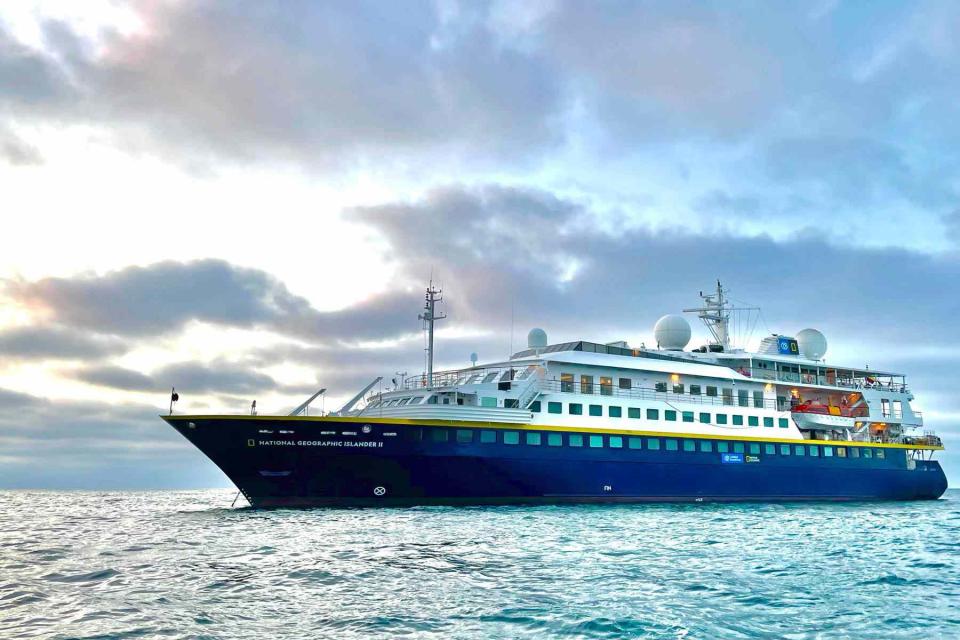
Bennett Goldberg
As someone who used to “borrow” his dad’s National Geographic magazines to cut out nature photos to tape to school binders, sailing the Galápagos Islands for the first time — on Lindblad Expeditions' new National Geographic Islander II — is as dreamy a trip as I could imagine.
“The area is like the nursery of the ocean,” said naturalist Ixora Berdonces of Santa Cruz — the archipelago’s most populous island. She waved out toward the mangrove ecosystem of Black Turtle Cove like she was conducting a symphony. Maybe playground was more like it, given all the action in this area off Santa Cruz. I was on an excursion aboard the National Geographic Islander II's small Zodiac motorboat with 11 other travel companions. We craned our necks, chirping out when we spotted another animal.
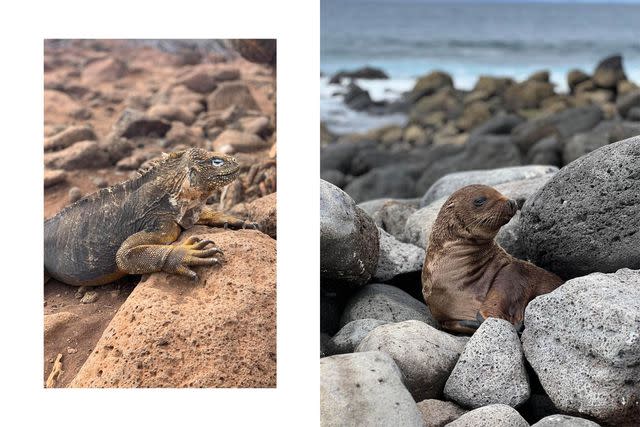
Nathan Tavares
Turtle! Pacific green sea turtles poked their heads out of the water like a thumbs-up from the ocean. Frigate birds! High overhead, the birds you’d swear were pterodactyls circled on giant wings. Blue-footed boobie! The birds banked hard and dive-bombed for fish.
The Zodiac slipped past long natural jetties of grass-fringed black volcanic rock, where boiled-red Sally Lightfoot crabs scuttled. Our driver, Daniel, drove deeper into the red-mangrove maze and then cut the engine, dropping a silent curtain over us, save for the occasional pelican squawk. Off Santa Cruz Island, we were 600 miles from mainland Ecuador — but it felt like we were the only humans around.
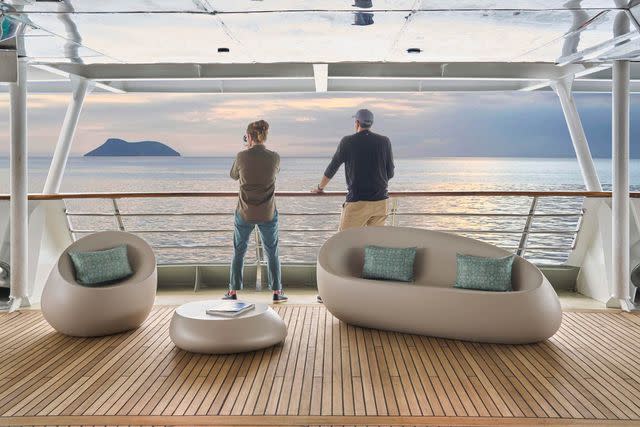
Marco Ricca
Only four generations of people have visited these islands, Berdonces explained, meaning the animals are “ecologically naïve” and don’t flee from humans. We were reminded of this when lions swirled right up to us as we snorkeled off the island of Isabela, and wove between stacks of sunbathing marine iguanas on Fernandina Island. We were just another part of nature. And our weeklong expedition on the National Geographic Islander II was just beginning.
The cynic might hand-wave the word “expedition” as marketing spin. But fans of laid-back cruising take note: This is a fast-paced trip., as the 6 a.m. wakeup calls quickly taught me, though I was thankful for the lessons brought by the packed itineraries.
“A cruise is in many ways more oriented inwards. The ship itself, and the activities on board, and the entertainment,” Lindblad chairman Sven Lindblad — whose father Lars-Eric led the first ecotourism trip of non-researchers to the Galápagos in 1967 — explained to me. “And an expedition is focused outward. So the ship is really a base camp in order to make that happen. We’re out in remote areas, and we’re not really reliant on any kind of infrastructures from the shore”
That's not to say that I was roughing it, though. The 280-foot National Geographic Islander II is less a ship, more a boutique hotel, where guests can sip craft cocktails or lounge in a hammock on the wraparound teak decks, lulled by the waves. Once a former superyacht before a top-to-bottom reimagining ahead of its August 2022 inaugural voyage, the ship boasts 26 suites for just 48 passengers, with a one-to-one crew-to-passenger ratio.
Each suite has two twin-size beds that can be merged into a king-size bed; gleaming marble bathrooms with double-sinks; and cushy sitting areas. There's also a flat-screen TV, especially handy as it displays the day’s schedule. Don’t expect to snag much TV time, though, given the competing ocean views offered by huge in-room windows. In-room espresso machines are as essential to those early mornings as the chipper wakeup calls from expedition leader Gaby Bohorquez.
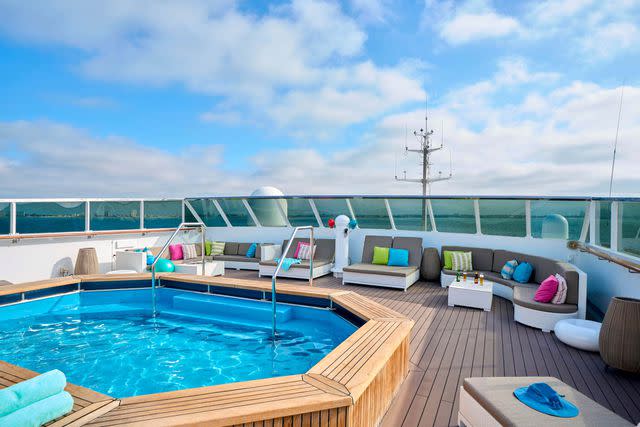
Marco Ricca
Elsewhere, you can unwind in the sauna, hit the plunge pool, or visit on-site wellness specialist Estefania Mateljan to knead your quads after a long day of hoofing it. Intimate public spaces pay homage to the cerulean webbed feet of the iconic blue-footed boobies, from the chairs and bookshelves of the on-board library, to the palette of the intimate Cove lounge, which pulls triple-duty as a hotspot for pre-dinner cocktails, information sessions, and lectures from researchers.
In the Yacht Club restaurant, meanwhile, the blue-upholstered banquettes beckon for meals of locally sourced and sustainable cuisine inspired by Ecuador’s four regions. Think: duck breast and South American cazuela stew made with wild Pacific wahoo and mashed green plantains, finished off with passionfruit cheesecake and house-made ice-cream. As posh as the surroundings are, I never felt out of place in my hiking cargo pants and scuffed boots.
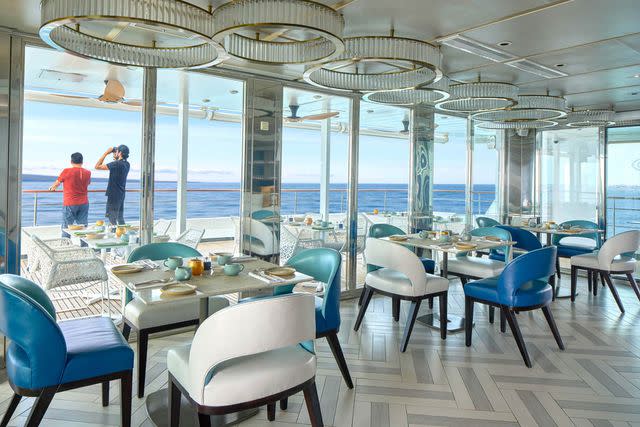
Marco Ricca
Speaking of out of place, we were reminded throughout the week of the delicate ecosystem of the islands. Our expedition leaders stressed the importance of giving the animals their space, leaving nothing behind, and taking nothing with us. And I felt at ease given Lindblad Expeditions' presence in the area since the 1960s and the carbon-neutral company’s work in conservation, research, and education in the area.
The brand also reserves rooms aboard each expedition for researchers and Ecuadorian naturalists, like Berdonces, who the Ecuadorian government tapped to head the National Marine Ecosystem Cleaning Project before she joined Lindblad.
“This belongs to them,” Berdonces said of the animals on our second day, as our bus wove down a dirt road on Santa Cruz Island. “We are just visitors to this island.” Once at our destination, the family-owned El Manzanillo ranch, where hundreds of giant tortoises roamed the sprawling grounds, she pointed at their shells. You can tell a tortoise’s age by their shell ridges; we encountered one who was probably over 90, per Berdonces. For creatures that live to be well over 100, we were just passing through. Sometimes they exhaled with a huff and slinked into their shells. Most of the time they just ignored us.
After a snorkeling safety briefing in the lounge, I asked Lindblad what he hoped guests take away from the excursion. “My hope is always that there’s a greater sense of reverence for natural systems, because it’s essential that we as human beings change our relationship with the environment,” he said.
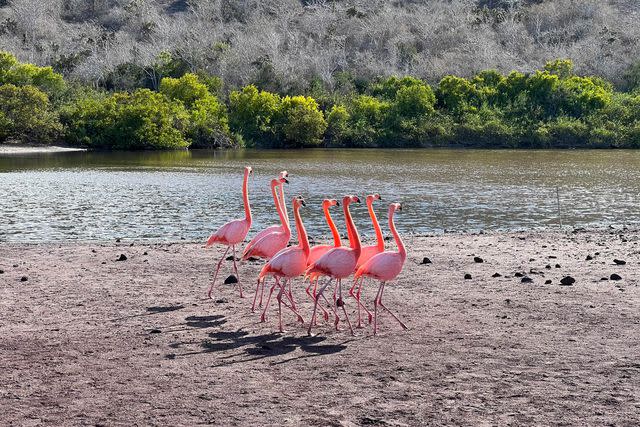
Nathan Tavares
That reverence hit me after a snorkeling excursion on the tiny island of Rabida, when I spotted a squad of 15 sherbet-pink flamingos at a lagoon. One flashed its black-tipped wings, then bobbed its head, and shuffled sideways. Soon, all 15 birds joined in the dance, moving as one.
Rates for the eight-day Wild Galápagos Escape aboard Lindblad Expeditions' National Geographic Islander II start at $9,390 per person.
For more Travel & Leisure news, make sure to sign up for our newsletter!
Read the original article on Travel & Leisure.

